Science
Frogs and Toads Together: Why do Amphibians Group Up?April 11, 2025

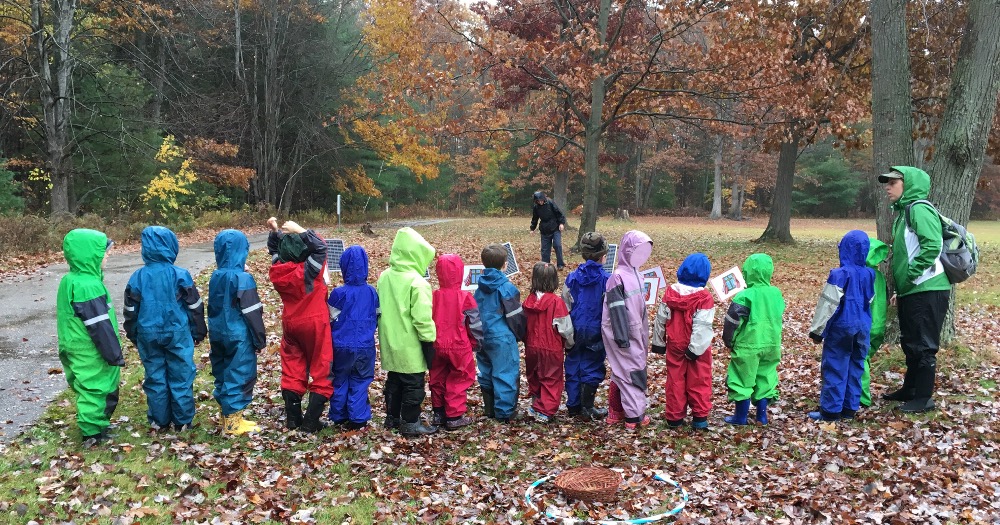
Outdoor education is a challenging thing to define, but most sources agree that it’s intentional or organized learning that takes place in nature or outside the classroom. Sometimes outdoor education is also referred to as outdoor learning, outdoor schools, forest schools, or wilderness education. But don’t let those names hold you back; outdoor education definitely has its place in public schools as well.
Don’t need all the info? Use this list to jump to the stuff you need:
Create an outdoor learning environment
Tips and tricks for setting up outdoor learning expectations
Take advantage of outdoor learning spaces
Safety while learning outdoors
Teaching holds many challenges and is a demanding job, so why add more to your plate? What are the benefits of outdoor education and are they worth your time and effort? After spending 10 years working with public education teachers and seeing how teaching through nature transformed their curriculum and their students, I can say from first-hand experience that yes it is so worth it!
But don’t just take my word for it! The members of LEAF, Wisconsin’s K-12 Forestry Education Program, analyzed and summarized the results of 23 different studies to determine the benefits of outdoor education. Below is a list of their findings:
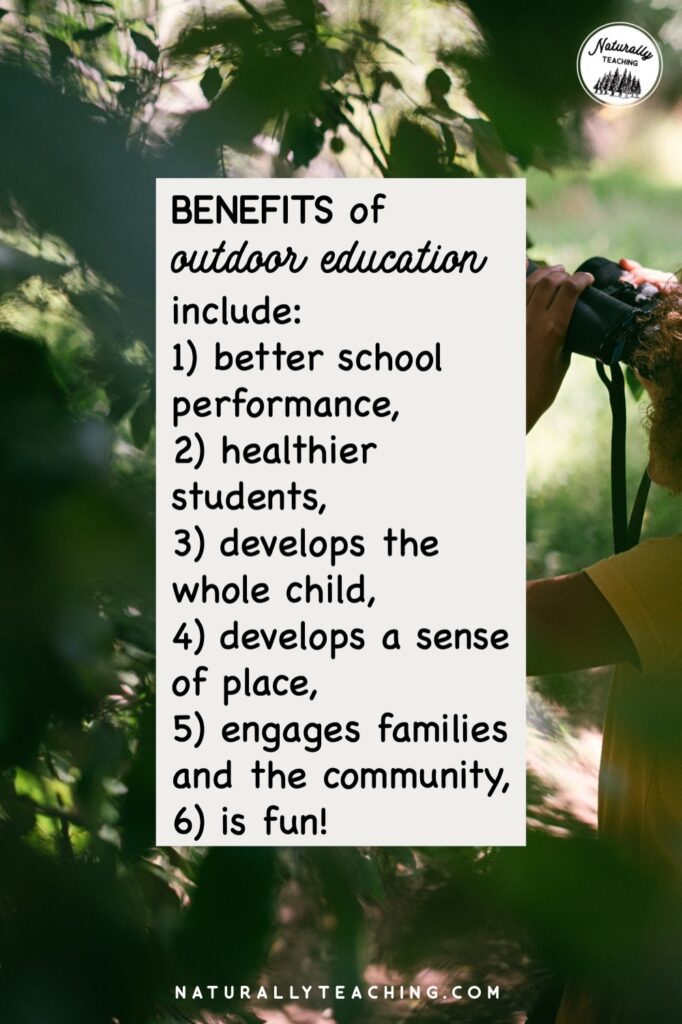
After that list of awesome benefits of outdoor education, you may be leaning more towards giving outdoor education a try. You may also be wondering what outdoor learning looks like. I’m here to help you with the overwhelm that can come with beginning the journey to outdoor learning with your elementary students.
The first and most important thing to remember is that outdoor education is just another way to teach using all the same skills you already have, just outside.
Remember that routine you set up at the beginning of the school year? Where to sit when your students come into the classroom? How to transition through the hallways? How to gain your students’ attention when they’re in the middle of a collaborative project? All of these same routines can be used outside to create an outdoor learning environment.
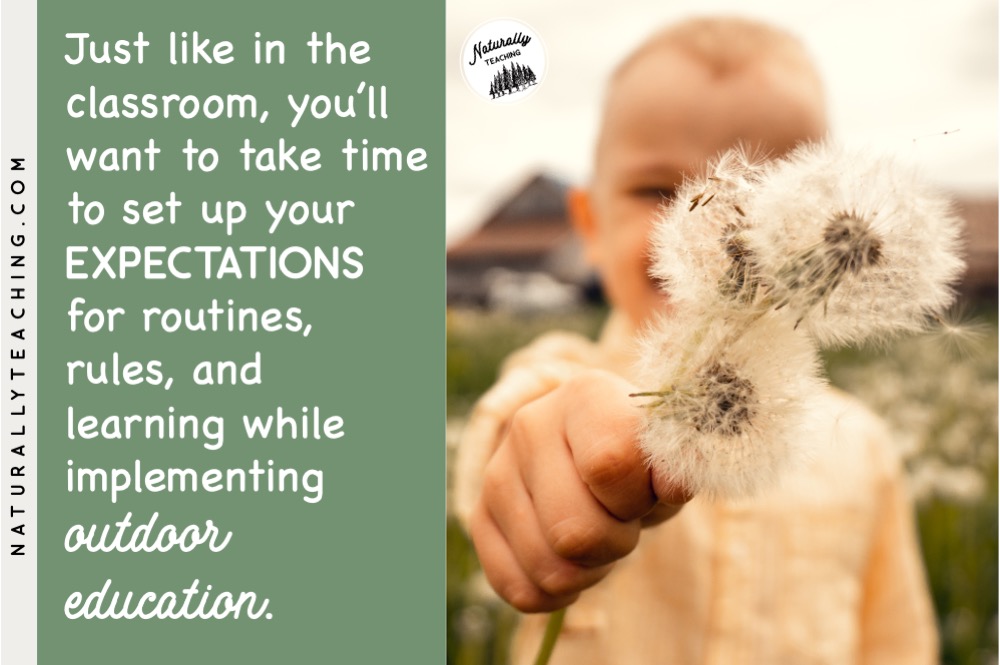
Just like in the classroom, routines are going to be important to creating an outdoor learning environment where your students know what to expect while learning outside. The transition to outdoor learning may take some time since it is likely new, but overtime, your students will understand your expectations and will learn just as well (maybe even better) in nature than in your classroom.
Just like in the classroom, you’ll want to take time to set up your expectations for routines, rules, and learning while outdoors. This will help make your students be more responsible for their own learning as well as save you time later in the year. Make your first few lessons short experiences designed to help your students practice routines.
Consider using your first week to practice routines that answer the following questions:
Your students will benefit from crossover in the classroom, especially if you have younger students. These rules and expectations can be the same as what you use in the classroom, as long as they are appropriate for their success learning outside. Spend some time thinking about how you want your students to interact with nature and then decide on routines that will help them be successful.
There are two types of outdoor learning spaces that I think of when I consider what this term means: man-made outdoor learning spaces and natural outdoor learning spaces.
Examples of man-made outdoor learning spaces could include a pavilion, a group of picnic tables, benches, a stump circle, cultivated gardens, and more. These sorts of outdoor learning spaces are great to use as gathering spaces for large group meetings or for individual work. If you don’t have one of these set up, don’t fret! They can always be added when you have time or volunteers, but they are not what makes or breaks your ability to use outdoor education in your teaching practices.
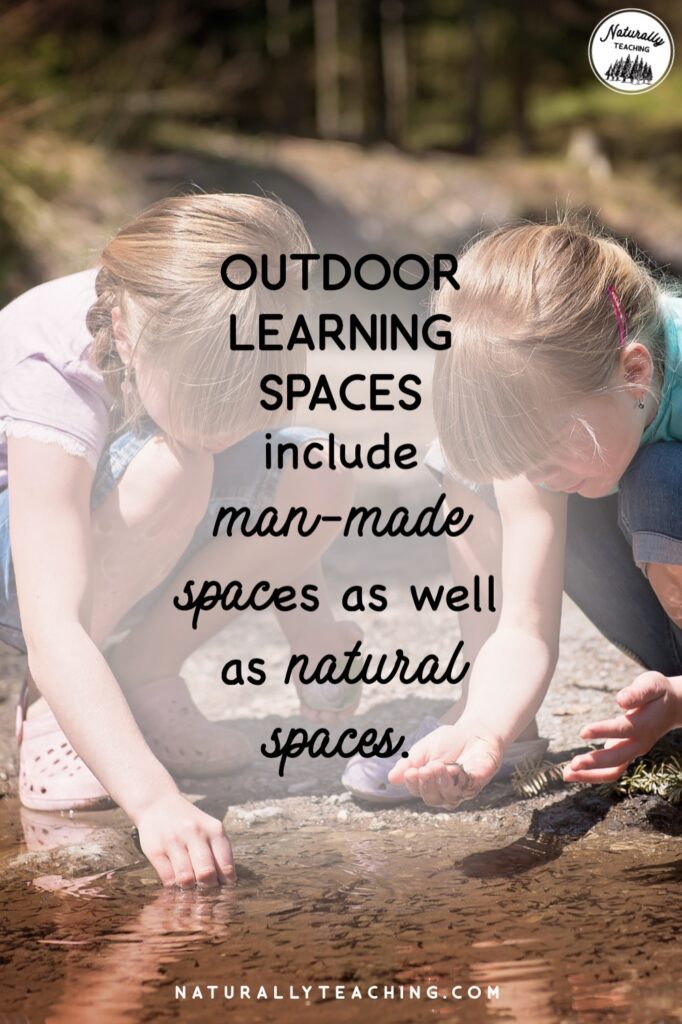
On the flip side, natural outdoor learning spaces are more important to your studies and will be what enhances your outdoor learning experiences. Examples of natural outdoor learning spaces include a section of the soccer field, a shade tree on your playground, a small forest behind your school, a ditch with cattails, an unmowed area of your schoolyard, and more. These typically are spaces that you don’t have to do much to maintain but provide you with opportunities to study nature or outdoor space to create experiences.
Nature is one of the most rich and inviting science labs that you can come across. And the best part about it? It’s free! If you can change your thinking and consider the possibilities of nature as an outdoor lab, you will transition well to using outdoor education in your elementary classroom.
Nature isn’t just an outdoor lab for Earth and life sciences either, it can be used across the board for all sciences and for other subjects as well. Why is nature such a perfect lab space? It is ever changing, providing more opportunities to work together to learn. It also has a natural ebb and flow that is created by cause and effect relationships in nature; these natural rhythms will provide your students many opportunities for critical thinking, experimentation, and analysis.
Nature based learning is a similar term to outdoor education, with a slight difference. As stated earlier, outdoor education is the intentional learning that takes places outside of the classroom and typically in nature. Nature based learning, however, is an educational approach that uses nature and natural elements as a vehicle for learning. Essentially, nature based learning uses nature, its elements, and its phenology to teach the standards assigned to each grade level.
This type of learning takes more time to set up since your curriculum would need to be written around your community’s nature. That being said, combining elements of nature based learning and outdoor education can positively impact your students and help you reach those benefits of outdoor education we discussed earlier.
So now that you’re convinced that you should embrace outdoor education, and maybe some nature based learning, how are you supposed to teach outside? Remember to set up those rules and expectations before you venture out and make sure to practice them with your students so that they know how outdoor learning is different from indoor learning.
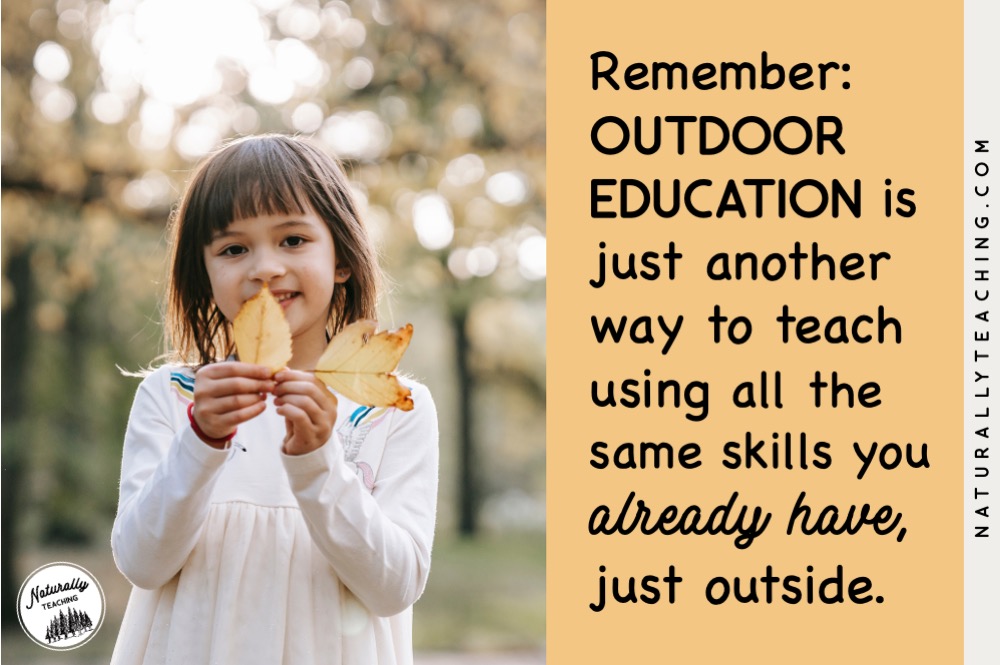
It’s also helpful to find a term that you want to use to refer to your outdoor learning time. Some examples include exploration, nature science, outdoor science, etc. When your student first go outside, they may associate the outdoor learning time with recess and free-playing; having a specific name for your outdoor learning time will help them understand that there is a difference.
Use the term you pick in your class schedule for the day and also while you’re outside to hold your students accountable. That being said, early childhood learners benefit from free-play. Setting aside some time at the end of each outdoor session will develop a predictable routine which will allow them to focus better during your lesson and will help their overall development.
The safety of learning outside is probably the most intimating part of taking students out to learn. Consider these points as you decide ways to keep your students safe.
Use natural boundaries to keep your students accountable for their safety. Natural boundaries include things that are very easy to see like sidewalks, fences, buildings, logs, playground lines, etc. When you begin each outdoor lesson, share with your students where they are able to go by walking around the boundaries or using very distinct and obvious markers. If you use the same space repeatedly, they will get into the habit of remembering the boundaries you’ve set. As the teacher, it’s best to select a space where you can see all children at all times with no blind spots. Make sure to count them repeatedly.
Share your safety expectations with your students. If your school is against climbing trees, remind your students of that at the beginning of your lesson. Remember that early childhood learners are not able to remember very many things at one time so try to keep it to simple rules like “keep each other safe and nature safe”. Then have them brainstorm ways that they can follow that rule. Have your students repeat the rules at the beginning of your lesson and hold them to them.
Make sure to carry a first aid kit with you while you’re outside. You may run into a situation where a student needs a band-aid, and it’s best to have it on you instead of having to take the entire class back inside to grab one; we all know how hard transitions can be! You should also have your cell phone or a walky-talky so that you can get in touch with the front office in case of emergency.
Have your students use the bathroom before going outside. Many teachers do not have support like a para-pro, so it’s important for all of your students to stay with you while you’re outside. Keeping track of the number of students you have with you is one of the best ways to avoid safety issues.
There are a variety of learning outdoor activities that you can use outside to benefit your students. I’m going to break down five different activity types but feel free to use your creativity and imagination to come up with other ideas to teach your curriculum in a new way (and then come back and let us know about it!). As you spend more time outside and your students get used to the routine, you can start to combine some of these ideas into the same lesson plan.
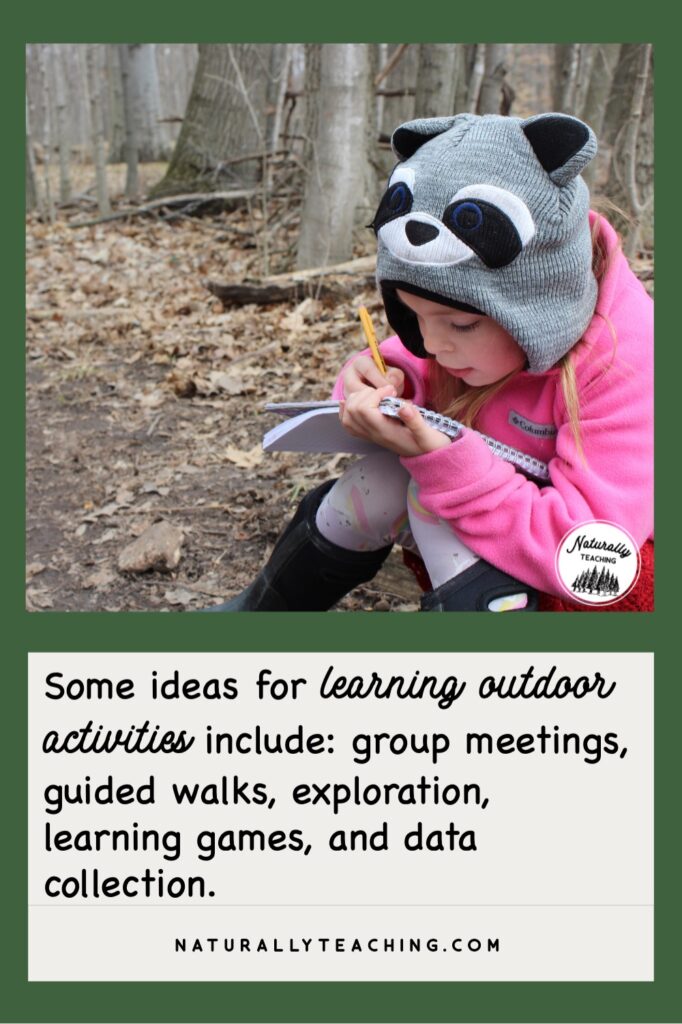
Having a group meeting at the beginning of each of your outdoor lessons is usually a good idea, especially for your early childhood learners. These meetings give you a chance to introduce the concept for the day and gives you space to provide your students directions. If you can swing it, try to use the same meeting spot for these group meetings.
Reading a related picture book in the group meeting space is always a great way to start off an outdoor lesson. Keep this part of your lesson brief though, about 5-10 minutes at most so that you can get to the experiential part of your lesson.
Guided walks can be useful if you want your students to experience the same thing at roughly the same time. A guided walk can take the form of a hike led by a teacher, paraprofessional, or another student that keeps the entire group together working on the same task. Some guided walk lessons could include finding textures in nature as you walk down the sidewalk or looking for seasonal signs in pairs while walking through the schoolyard.
These opportunities resemble more of what’s happening inside your classroom and could be used as a good transition into outdoor learning.
Exploration-based activities can be very powerful for children’s learning, especially early childhood learners. Some exploration-type lessons could be scavenger hunts for living and nonliving things in your schoolyard or gathering leaves for comparison of shapes and colors.
Not only can these types of lessons develop a sense of responsibility in your students, but they can also give you the unique opportunity to check in on your students independently as they make their way through the activity you laid out.
One of the most powerful ways to use the outdoors for learning is the use of learning games. When concepts are gamified, they build a different understanding in your students’ brains because they are experiencing the phenomenon firsthand, or they are creating a memory that they can call on later to remember the information.
Some learning games could include relay races of frog life cycles or living vs nonliving things. My favorite games are ones that put your students into the role of the concept like Bear, Bear, Are You Awake? (original source unknown). This is a game about a sleeping bear which helps teach the concept of dormancy in animals during the winter.
Being in the outdoors gives you a wonderful opportunity to collect data. This scientific skill is sometimes hard to come by naturally in the classroom, so take advantage of your schoolyard or greenspace to provide you with things to count, tally, measure, and more. Some examples include taking temperatures outside, measuring the height of plants, taking animal surveys, and more.
Remember, this is just a short list of learning outdoor activities. You’ll find new and creative ways to spend your time outside with your students as you practice going out more and finding out what resonates with your kids. Just keep in mind that mixing up activity types will reach more of your learners and will keep things fresh and exciting, upping your engagement.
Teachers already have too much of a burden on their shoulders to supply learning materials and equipment…adding outdoor education to your educational practices shouldn’t add a financial burden to you as well. You can learn outside without any special kind of outdoor learning equipment.
That being said, there are some things that are nice to have on hand, a lot of which you can find at garage sales or could acquire through donations from parents or local businesses. I’ll break down some of my favorite outdoor learning equipment and the reason I find them so valuable.
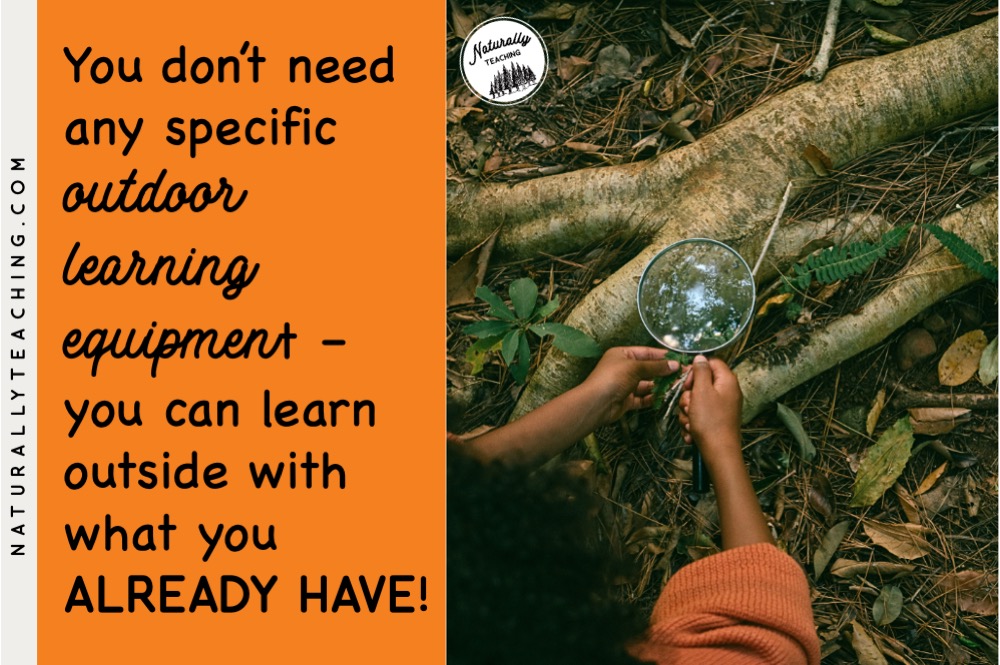
Sometimes you will have a lot of stuff to take outside with you for your lesson – think science notebooks for each kiddo, drawing utensils, game materials, etc. Having a foldable wagon on hand is very helpful. Not only will it collapse and be stored out of the way, it will also be an easy way to prep your materials so that you don’t have to run around wondering if you have what you need. Having waterproof material in the wagon is a bonus, especially if you plan to explore ditches, ponds, or creeks near your school.
Playing learning games outside will help your students better understand your material, but sometimes those games will take props. Some reusable and transformative props include poker chips, ropes, poly spots, and cones.
Poker chips are great loose parts that can become food for hungry animals, data collection tools, pollen from flowers, and more. It’s nice to have multiple colors in case you need to designate different aspects of learning through the different color chips.
Ropes and cones are helpful for identifying boundaries. Ropes are light and provide a nice defining boundary that can extend for a long distance. Cones are tall and can help define boundaries with a quick glance. It’s nice to have different colors for these as well in case you are defining boundaries with different teams. Combining ropes with cones is helpful because cones are tall and can be seen while away from the boundary line while ropes can extend the entire length of your boundaries.
Poly spots are great for defining individual spots for students or for creating obstacles in an obstacle course. It’s nice to have these in different colors as well just in case your game calls for different colored teams. These tend to be heavy so having them in a backpack or in your wagon may be the best way to transport them.
Alternatively, I have seen teachers collect milk jug lids to use in place of poker chips and I’ve seen tall jugs filled with sand to be used instead of cones. Get creative and find ways to save yourself some cash while also getting the benefits of these game materials for your class.
Although these tools are labeled as being bug and butterfly specific, these exploration tools are helpful not just for invertebrates, but for collecting a variety of items from nature. I have used bug boxes to collect different levels of the food chain, living and nonliving things, different colored things, and so much more.
These bug jars tend to be sturdier than some of the others on the market and their magnifying glass at the top is helpful for closer observation. These bug boxes are a decent alternative, but the bottoms are more fragile and tend to crack easier. If you do acquire bug boxes that have a separate lid and bottom, remind your students to hold one in each hand unless their box is closed in order to keep your bug boxes as a unit.
A good butterfly pavilion is nice for flying insects but can also be helpful for imaginative play or collection of *soft* natural items. They tend to be collapsible and easy to transport for outdoor exploration. This style of butterfly pavilion is nice because it has one easy to open side door. There is also this type of butterfly pavilion but I have noticed that the wire ring at the top ends up poking out and ruining the integrity of the equipment after a few years of use.
Alternatively, you could get a bunch of reusable plastic containers from a thrift shop, a dollar store, or a garage sale and poke holes in the top for animals to breathe, and call it good. Plastic containers can work pretty well if you’re working with a small budget and/or no help from administration or donations.
Believe it or not, many children get into identifying what they are finding when they are outside exploring. Field guides are such a helpful tool for your inquisitive learners that want a name for everything. These books can add up, so check your Scholastic catalogs to see if they have any at cheaper prices, or see if there are any local book stores willing to donate a handful, you really don’t need many.
Alternatively, you could work with your students to create their own field guides on the computer and make field binders that they could take outside. Also, if you have access to an iPad or you have the okay from administration to use your phone, you could download the free app Seek by iNaturalist to help you identify what you’re finding with your students.
Hopefully after reading this article you have a better understanding of what outdoor education is and how it can help you and your students in your educational journeys. Although it may sound intimidating at first, take it slow and see if it fits you and your students. Feel free to send me an email or send me a DM on Facebook or Instagram if you need any tips or you want to celebrate a success! I’d love to hear from you.
Bibliography
LEAF Program. (n.d.) Outdoor Education. Research Summary, 1-4. Retrieved from https://www3.uwsp.edu/cnr-ap/leaf/SiteAssets/Pages/School-Forest-Research/Outdoor%20Education%20Research.pdf
Do you have any amazing experiences using outdoor education in your classroom? Describe them in the comments section to inspire a fellow elementary teacher to take action!
Check out this podcast episode for ways to set up your outdoor learning environment!
Looking for some outdoor education ideas? Check out these other articles:
A Helpful Guide to Teaching About Fall in Elementary School
“The Snowy Day” Ezra Jack Keats: 15 Fun Activities for Early Childhood Learners
A Helpful Guide to Teaching the Season Transition to Winter
How Do You Celebrate the Winter Solstice with Elementary Students?
How Vernal Pools Can Be Used to Reach Your Curricular Goals
How Maple Syrup Season Can Help You Teach Elementary Students
16 Activities for Groundhog Day Inspired By the Book “Groundhog Weather School”
A List of Earth Day Activities Elementary Students Will Love This Year
Teaching the Weather of Summer: A Helpful Guide for Elementary Teachers
Amphibians Vs Reptiles: How to Teach the Difference in Your Elementary Classroom
Pollination for Plants: How to Use “Flowers Are Calling” for Effective Teaching
3 thoughts on “Outdoor Education: How to Use Nature to Improve Your Science Studies”